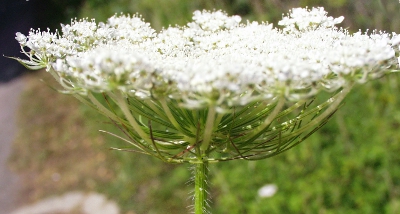Daucus |

Umbel of the wild carrot

Culture forms of the carrot are available in different varieties
The Staphylinos of Dioskurides, can, however, be explicit assigned, because he meant quite clearly the wild carrot, while Pliny Staphylinos attributing a sharp taste and refers to it as wild parsnip. That might be the reason that the herbal book by Leonard Fuchs (1543) called two plants parsnips, that we now know as carrots, and Bauhin in his in his Pinax (1623) designated the wild carrot as Pastinaca tenuifolia. Linnaeus separated in 1753 finally the genera Daucus and Pastinaca.
The etymology of Daucus is not clear, but the term "carrot" was created from the epithet carota, a Latin name for the carrot, which goes back to the Greek Karoton. It may be a derivative of gr. Kar (louse), what shall refer to the shape of the fruits. According to some linguists, also the name Carum, used for caraway, has its origin in Kar.
Comprising more than 20 species, the genus is native to Eurasia and North Africa. However, through the cultivation of the garden carrot it can be found in all temperate zones of the world. The members of the genus are usually annual to biannual, herbaceous plants with taproot. The stems are erect or rarely prostrate, more or less branched and hirsute or bristly. The 2- to 3-fold pinnate leaves are arranged opposite or in false whorls. The leaflets are linear to lanceolate or ovate and usually acute. The leaves are gradually reduced upward in size, the lower ones are stalked, the upper ones sessile. The sheathing leaf bases clasp the stem completely.
The inflorescences are double umbels, arranged axillary and terminal, rarely they are almost sessile in the leaf axils. The bracts of the umbel, the so-called involucre, is missing or consists of leaf-like, three-piece or pinnate leaves, which are usually directed downward. The umbel with 4 to 60 rays splits into umbellules which bear white, pink or yellow flowers. The mostly numerous, serrated or entire bracts form the involucel. The calyx teeth are inconspicuous, rarely clearly visible.
The flowers are small and hermaphrodite, their petals are curved inward at the top. The marginal petals are more or less enlarged. The styles are 1–3 mm long and arise from a conical stylopodium. After insect pollination the inferior ovary forms elongated to ovoid, flattened, ribbed schizocarps, which fall into two parts. Each individual mericarp with 4 winged and spiny ribs. For fruit time, the inflorescence closes together like a nest.
| Floral formula: |
| * K5 C5 A5 G(2) inferior |
Historical publications
Pliny (about
23–79 AD.) resulted in
his Natural History two different Daucus
species, which are now interpreted as Athamanta cretensis
and Peucedanum cervaria. Behind his as wild parsnip
designated Staphylinos
suspect some the wild carrot. Furthermore Pliny mentioned a kind of
parsnip that would called the Gallic, but the Greeks would name it Daucus.
Dioscorides (1st century AD.) described in addition to the wild carrot another species: Daucus gingidium, the sea carrot. The Gingidium, he wrote, is simile to the wild carrot and possesses a slightly bitter tasting white root, that will eaten cooked or boiled as a vegetable. It was diuretic and gentle to the stomach.
Meaning of the species names
- carota: lat. carota = carrot
- sativus: lat. sativus = sown, referred useful plants
Interesting notes
-
The spines of the fruit have small barbs, so that they easily stick in the fur of animals, which spread the fruits in this way.